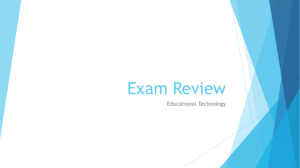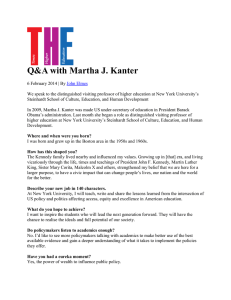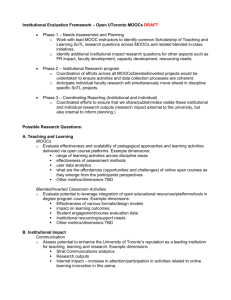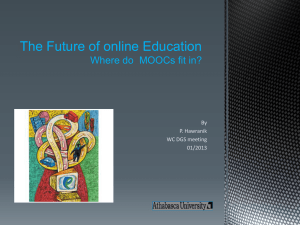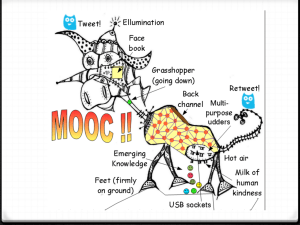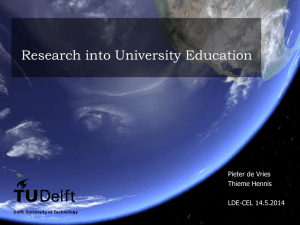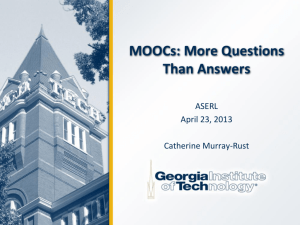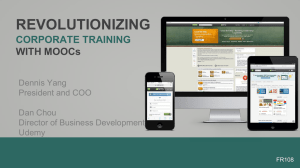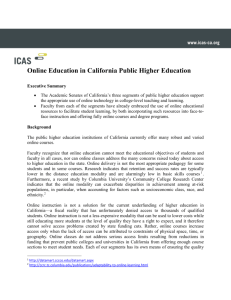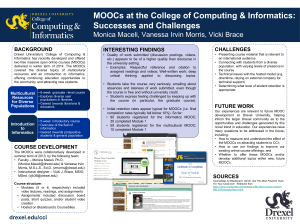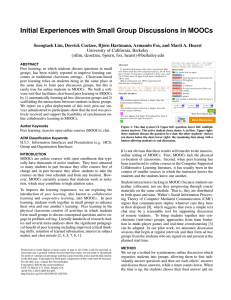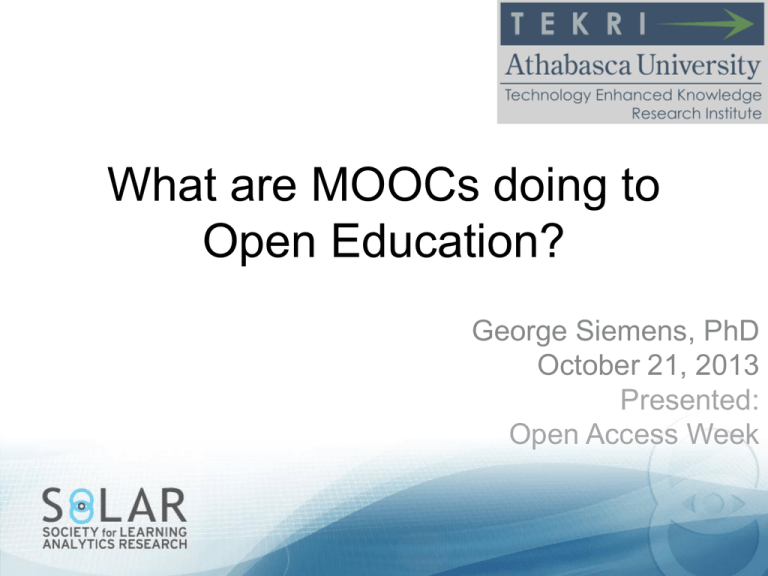
What are MOOCs doing to
Open Education?
George Siemens, PhD
October 21, 2013
Presented:
Open Access Week
Short answer: destroying it
Intent of this presentation:
Argue for openness as a cornerstone of
innovation, creativity
Detail the new value ecosystem emerging in
higher education, driven by (for now)
MOOCs
MOOCs
$$$
Prestige & Influence
Massive: ok
Open: this is where things get confusing
Online: ok
Course: ok
Seven Stages of Open in
Education
1. Open access:
OU/AU, open universities
2. Open content:
OCW Consortium, MIT/Connexions/OpenLearn, CC
license
3. Open Teaching:
MOOCs
4. Open Credit/Assessment?
5. Open Degree?
6. Open data/analytics
7. Open System: OER U
What the hell happened
between here
MIT OpenCourseWare makes the
materials used in the teaching of
almost all of MIT's subjects available
on the Web, free of charge. With
more than 2,000 courses available,
OCW is delivering on the promise of
open sharing of knowledge.
and here?
All content or other materials available on the Sites,
including but not limited to code, images, text, layouts,
arrangements, displays, illustrations, audio and video
clips, HTML files and other content are the property of
Coursera and/or its affiliates or licensors and are
protected by copyright, patent and/or other proprietary
intellectual property rights under the United States and
foreign laws.
or here
All of our educational
content can be reused
according to the Creative
Commons licensing that we
have adopted and where
this logo is seen:
and here?
The Online Content and Courses
IPR is protected to the fullest extent
possible by copyright laws. All such
rights are reserved.
Knowledge and Innovation
We always lived in a connected
world, except we were not so
much aware of it…That has
changed drastically in the last
decade, at many, many different
levels.
Albert-lászló Barabási
Knowledge is a pattern of connections
New knowledge builds on (relates to) what is
already known
Innovation requires openness for new
connection forming, new creations, new
mashups
870k papers
visualized
http://cmap.ihmc.us/
Linking Open Data cloud diagram, by Richard Cyganiak and Anja Jentzsch. http://lod-cloud.net/
Wheels
Steam
Viability
Motion
Transportation need
Entrepreneurship
Scientific progress
Metal workers:
cylinders
“a thousand threads that lead from
the locomotive to the very beginning
of the modern world”
Rosen, 2010
“The process may be more like
stitching together known parts than
pioneering a complete route from
scratch”
W. Bryan Arthur, 2006
A new value ecosystem
October, 2001
Courtesy of Apple
April, 2003
October, 2005
TV shows, music videos
(September, 2006, full length movies)
January, 2007
Courtesy of Apple
Network theory of value and
change
The integration of services provides the
value for end users
Easy trumps ideology (openness)
Networks become powerful through
lock-in and integration
i.e. what they exclude
Silicon Valley
Shockley
Terman
Today in education, we are witnessing
an unbundling of previous network
structures.
And a rebundling of new network lock-in
models.
MOOCs are a keystone concept in
reformulating education models
and creating new ecosystems
Power is shifting…
State/public universities are concerned
Network effect of small number of big
winners
Faculty losing influence, individuals gaining
New entrants (VC-backed)
Learner control (?)
Downes, 2013 (Antalya, Turkey presentation)
Soft is hard and hard is easy
Jon Dron
A university as
“assemblage of strangers from all parts in
one spot”
J.H. Newman Lecturers 1854-1859
When closed:
- Information doesn’t flow
- Connections don’t form
- Diversity is diminished
- Knowledge development is hampered
Conference
December 5-6, 2013
University of Texas Arlington
http://www.moocresearch.com/
Twitter/Gmail:
gsiemens


